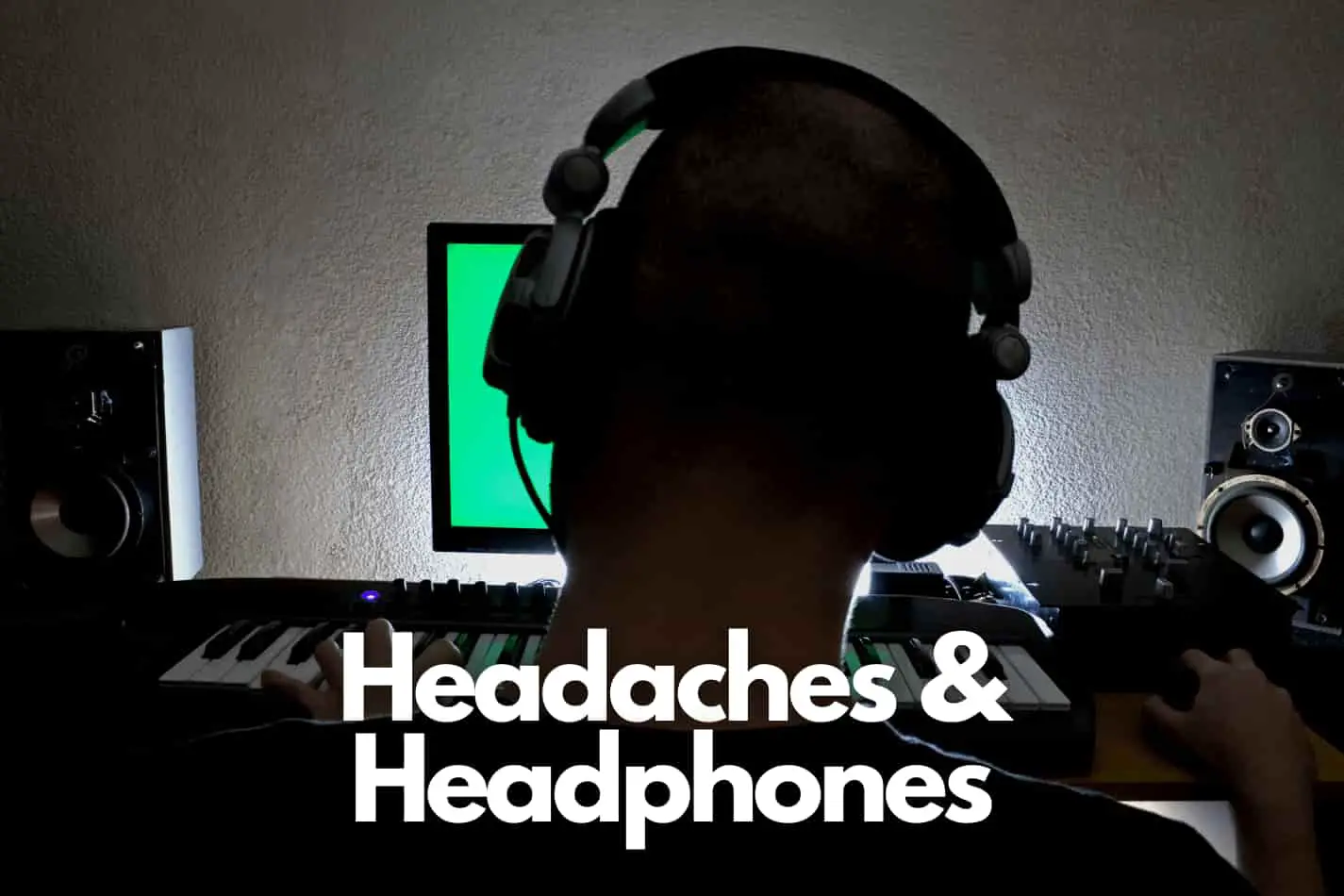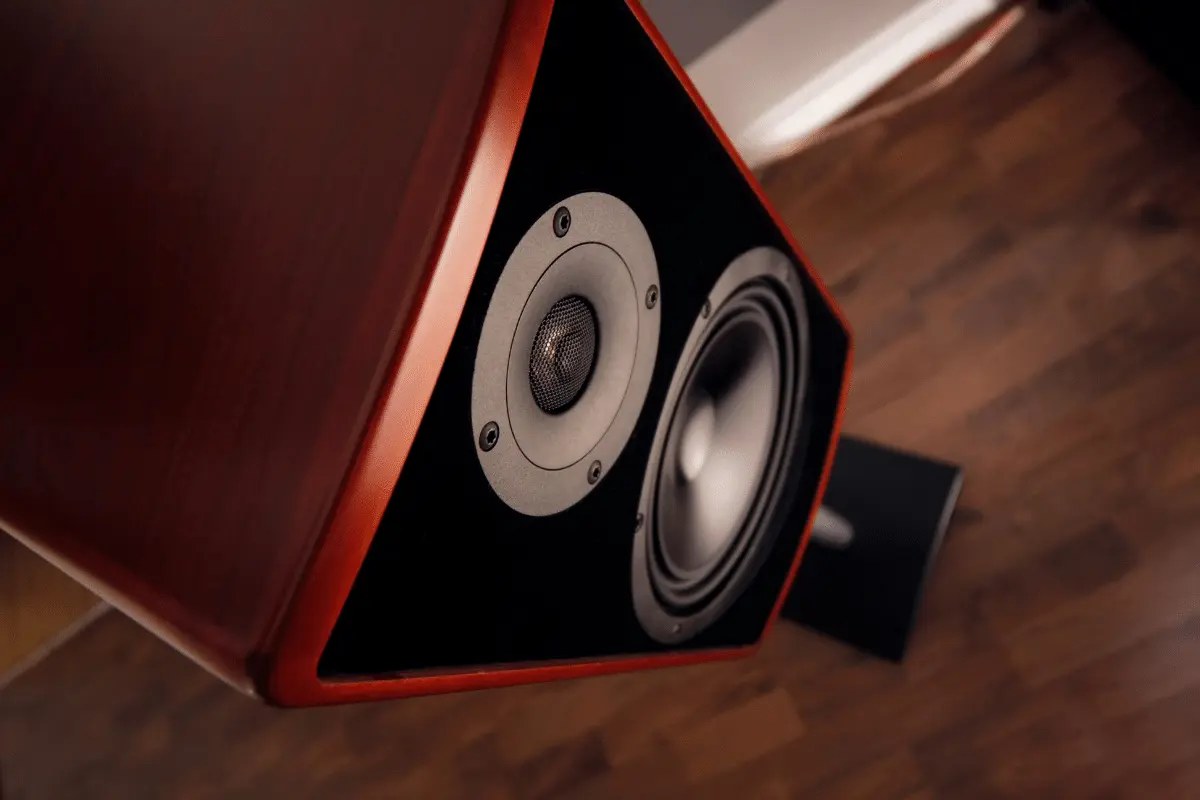Are you one of those people who just can’t seem to get through the day without a headache? Do over-the-ear headphones always seem to be the culprit? If so, you’re not alone.
Many people find that these headphones cause pain and discomfort in the temples and ears. But why is that? What’s behind this common problem and why do over-the-ear headphones cause headaches?
Over-ear headphones are one of the most popular reasons for migraines and other headaches. Extremely loud or extended sounds can trigger migraines and other headaches, as well as over-ear headphones’ uncomfortable clamping pressure which builds up after a few minutes to hours of wearing.
If this sounds familiar to you then today we will look into how to avoid headaches from over-ear headphones and why they happen in the first place. Since there are quite a few reasons why people tend to get headaches from over-ear headphones let’s dig in.

Is it True That Headphones Cause Headaches?
This is a difficult question to answer because it really depends on the person. Some people are more susceptible to headaches than others, and there are a variety of factors that can contribute to why someone might get a headache.
For example, if you’re someone who is prone to migraines, then you might find that over-ear headphones trigger them more easily.
On the other hand, if you don’t usually get migraines but you find that your over-ear headphones are giving you headaches, it might be because of the way they’re designed.
How Do Over-Ear Headphones Cause Headaches?
There are a few different ways that over-ear headphones can cause headaches. One of the most common is due to the headphones’ clamping pressure.
This is the pressure that the headphones put on your head, and it can build up over time, especially if you’re wearing them for extended periods.
Why Would Wearing Headphones Cause Headaches?
The human head is sensitive(1), and when you add the extra pressure of headphones, it can be enough to cause a headache.
It’s not just the pressure from the headphones themselves, but also the way that they block out sound.
Your head is constantly bombarded with sounds, even if you don’t realize it. When you put on over-ear headphones, you’re essentially cutting yourself off from those sounds, which can lead to sensory deprivation.
Sensory deprivation has been linked to a number of different problems, including headaches but, oddly enough, has also been shown to help with migraines.
Frequent Causes Behind Headphone Headaches
When looking at headphones there are some things that could cause you to experience headaches more frequently such as:
- The headphones are too tight
- Wearing the headphones for too long
- Having the volume on your headphones turned up too high
All of these can contribute to why you might be experiencing headaches more frequently. Let’s take a look at each one in a little more detail.
They Are Simply Too Tight
A simple but very common cause of headaches from over-ear headphones is that they’re just too tight.
If the headphones are putting too much pressure on your head, it can lead to pain and discomfort.
To avoid this, make sure that you’re not tightening the headphones too much when you put them on. You should be able to fit two fingers between the band and your head, and the ear cups should be snug but not too tight.
If you find that the headphones are constantly slipping off your head, there are a few things you can do to remedy this.
They Aren’t Suited For Your Ears
Choosing the incorrect size of headphones is another frequent cause of headaches. If the ear cups are too small, they can put pressure on your ears, and if they’re too big, they can allow too much sound to leak in.
To avoid this, make sure that you try the headphones on before you buy them. If you’re buying them online, look for a retailer that offers free returns so that you can exchange them if they’re not a good fit.
Shallow Ear Cup Padding
If you have larger ears you need to be careful of headphones with shallow ear cups.
This is because they can cause pressure to build up on the front of your head, which can lead to headaches.
To avoid this, look for headphones with deeper ear cups or ones that have an adjustable headband so that you can loosen them if necessary.
Excessively Wearing Headphones
Another common cause of headaches from over-ear headphones is wearing them for too long.
Remember, your head is sensitive, and the pressure from the headphones can build up over time.
If you’re wearing them for hours at a time, it’s not surprising that you might start to experience some pain and discomfort.
To avoid this, take breaks every so often when you’re wearing headphones. Get up and walk around, or simply take them off for a few minutes to give your head a break.
You should also make sure that you’re not wearing them too tight. As we mentioned before, the headphones should be snug but not too tight.
Volume Too High Consistently
If you’re constantly listening to music at a high volume, it’s not surprising that you might start to experience headaches.
Remember, your head is sensitive, and the constant bombardment of sound can be enough to cause some pain.
To avoid this, make sure that you’re not listening to music at a high volume for extended periods of time. If you are, take breaks every so often to give your ears a break.
Using Headphones Not Built For Glasses
If like me you wear glasses a solid amount of the day you need to be even pickier with the types of headphones you use.
This is because some headphones can put pressure on your temples, which can lead to headaches.
To avoid this, make sure that you’re using headphones that have been designed for people who wear glasses.
There are a number of different brands that make them, so take your time to find a pair that’s comfortable for you.
How To Avoid Headaches From Headphones?
Looking for some simple methods to avoid headaches? Well, have we got some solutions below that will take you no time to implement but could save you a lot of pain in the future.
Invest In Some High-Quality Headphones
If you find that you’re constantly experiencing headaches from your headphones, it might be time to invest in a pair of high-quality headphones.
There are a number of different brands that make great headphones, so do your research and find a pair that’s comfortable for you.
Limit Length Of Time You Wear Headphones
Try to stop wearing them constantly throughout the day and give your ears a break.
You should also make sure that you’re not wearing them too tight. The headphones should be snug but not too tight.
Avoid Wearing Headphones When Not Actively Listening
Many will wear their headphones regardless of if they are even listening to anything.
This can put unnecessary pressure on your head and eventually lead to headaches.
Adjust Your Headphone Straps and Length to Your Head
Getting that perfect fit is key to preventing headaches from headphones.
You want the headphones to be snug but not too tight and also make sure that they’re not putting pressure on your temples.
If you can find a pair of headphones with an adjustable headband, that’s even better.
Ease Into Headphone Use If You Are New To Them
If you’re not used to wearing headphones, it’s important to ease into it.
Start by wearing them for shorter periods of time and gradually increase the amount of time you’re wearing them as you get more comfortable.
Avoid Excessive Volume & Constant Changes
When you are wearing headphones, try to avoid excessive volume and also sudden changes in volume.
Both of these can cause headaches, so it’s best to keep the volume at a consistent level.
If you need to make a sudden change, do it gradually to give your ears time to adjust.
Take More Frequent Breaks
Whenever possible, take more frequent breaks when wearing headphones.
This will give your head a chance to rest and also prevent any discomfort or pain.
If you find that you’re constantly experiencing headaches from your headphones, it might be time to invest in a pair of high-quality headphones. There are a number of different brands that make great headphones, so do your research and find a pair that’s comfortable for you.
Additionally, try to limit the amount of time you wear headphones and take more frequent breaks to give your head a chance to rest.
Adopt And Experiment With Other Headphones
Regardless if they are the most expensive headphone on the block or budget options, if they don’t feel right experiment and test out other headphones until you find a comfortable fit.
Wearing headphones should be a comfortable experience, not one that puts additional strain on your head and causes headaches.
Finding A Comfortable Pair of Headphones That Will Not Create Headaches
Sound quality alone isn’t the sole reason why people purchase headphones.
Comfort is another essential factor, especially for those that wear their headphones for long periods of time.
Unfortunately, not all headphones are created equal in terms of comfort. In fact, some can actually cause headaches just due to construction and shaping.
Headphone Weight
A key to comfort is the weight of headphones. The ideal weight for headphones is around 6-7 ounces.
This is the sweet spot where they are light enough to not cause any neck strain but also heavy enough to stay in place.
For many this amount of weight comes from buying the more expensive headphone options on the market.
Overall Headphone Padding
The type of headphone padding can also play a role in the comfort and whether or not they will cause headaches.
Over-the-ear headphones usually have the thickest and most comfortable form of padding.
This is ideal for those that wear their headphones for long periods of time as it evenly distributes the weight and pressure.
Earbuds, on the other hand, can be more difficult to keep in place and often have thinner forms of padding that can cause discomfort after extended use.
Headphone Clamping Force
Clamping can be a HUGE problem and concern for many headphone shoppers. Clamping is the force with which the headphones grip your head and ears.
For some people, a tight clamp can cause headaches due to the constant pressure being applied to the head.
It is important to test out headphones before purchasing them to ensure that they don’t have too much clamping force.
An easy way to test this is by putting the headphones on and then lightly tugging on them. If they don’t budge then they more than likely have too much clamping force.
Headphone Ear Cup Size
Ear cup sizing also plays a role in headphone comfort. Ear cups that are too small can cause ear pain and discomfort after extended use.
On the other hand, ear cups that are too large can cause headaches due to the constant pressure being applied to the head.
It is important to find a pair of headphones with ear cups that fit snugly around your ears without causing any pain or discomfort.
Headphone Adjustment Options
All additional options are important when it comes to finding a comfortable pair of headphones.
Headphones that have the ability to swivel and pivot are usually more comfortable than those that don’t as they can be adjusted to fit your head perfectly.
Additionally, headphones with adjustable headbands are also more comfortable as they can be adjusted to fit any size head.
Final Thoughts on Headaches Caused By Over-The-Ear Headphones
As you can see, there are a number of different reasons why over-ear headphones might give you headaches whether they are wireless headphones, active noise-canceling headphones, or even budget no-frills choices.
If you’re experiencing this problem, make sure to take a look at the factors we’ve mentioned and see if any of them apply to you so that you can find more comfortable headphones.
Once you’ve identified the cause, it should be relatively easy to find the best pair of headphones that are more comfortable and won’t give you headaches.




Leave a Reply
You must be logged in to post a comment.